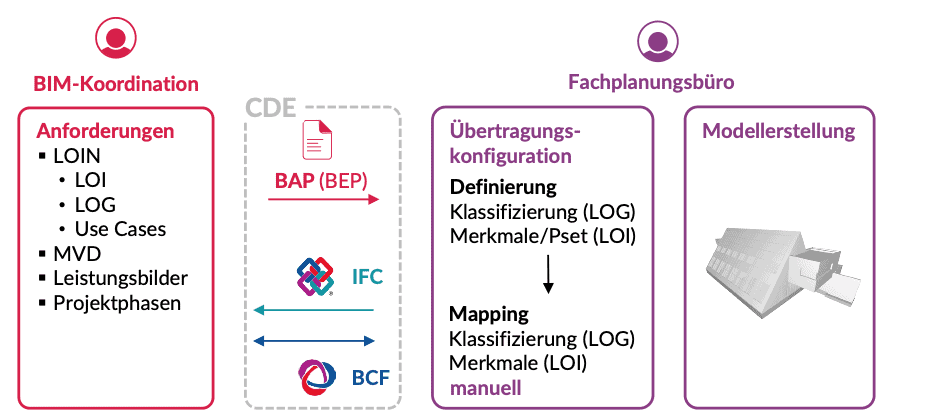This chapter provides an in-depth insight into various openBIM standards developed by buildingSMART. These new openBIM terms– especially the abbreviations – are a major challenge, especially for newcomers. A sound understanding of these terms is essential for extensive use of openBIM . The contents of this chapter provide the foundation for the descriptions of openBIM project implementation in chapter 4.
Fig. 3.1 and Fig. 3.2 put the terms into context. In contrast to the overview illustration in Chapter 4, the entire openBIM process within a project is not shown, but only from the perspective of model creation. For more detailed information, please refer to the individual sections.
The specialist planning office receives the model requirement (including LOIN, section 3.6) via the BIM execution plan (BAP) and begins to implement it in its native software. Before starting with the actual specialist model creation, the first step is to create the new classifications (if permitted by the software guideline) and the necessary features in the software. In the second step , these are mapped (for the IFC export) with the IFC data schema or MVD(Section 3.2 and Section 3.3). The specialist model creation then starts in accordance with the modeling guidelines(section 3.1.3). The office transfers the models using IFC and communicates via BCF(Section 3.4). The entire exchange of information takes place via a Common Data Environment (Section 3.5). The described mapping must be carried out manually by each project participant in the respective native software; this is not very efficient and is prone to errors.

An improved method is the use of a data structure tool(Section 2.3.3), through which the definition and mapping of classifications and characteristics / property sets (Section 3.2.3) is carried out centrally for several software products and the IFC data schema or MVD(Section 3.2 and Section 3.3). These are linked simultaneously with the service profiles(Section 2.5), project phases and use cases(Chapter 4) in a database. In addition, classifications and characteristics from the bSDD(section 3.8) can be integrated directly using an API. The results are software-specific templates or the IDS standard(section 3.7), which can be imported directly into the software if the software supports the standard. Manual input in the modeling or testing software is no longer necessary. Who performs these activities in the data structure tool depends on the respective project and organization, as the data structure tool can be provided centrally by the client and/or each actor uses their own data structure tool.

Some sources and recommended reading for chapter 3
- Borrmann A., König M., Koch C. and Beetz J. (eds.): “Building Information Modeling:TechnologischeGrundlagenundindustriellePraxis“. Second, updated edition, Springer Fachmedien, Wiesbaden, 2021, ISBN: 978-3-658-33361-4(Link)
- Borrmann A., König M., Koch C. and Beetz J. (Eds.): “Building Information Modeling: Technology Foundations and Industry Practice“. Translated and Extended from the German Version, Springer International Publishing AG, Cham, 2018, ISBN: 978-3-319-92862-3(Link)
- Hausknecht K. and Liebich T.: “BIM Compendium – Building Information Modeling as a new planning method“. Fraunhofer IRB Verlag, Stuttgart, 2016 (2nd edition announced for 2024, link)
- Scherer R. J. and Schapke S.-E. (eds.): “Informationssysteme im Bauwesen 1: Modelle, Methoden und Prozesse“. Berlin, Heidelberg, Springer-Verlag Berlin Heidelberg, 2014, ISBN: 978-3-642-40882-3(Link)
Publication from Eichler, C.C., Schranz, Ch., Krischmann, T., Urban, H., Hopferwieser, M., Fischer, S.: BIMcertHandbuch- Grundlagenwissen openBIM. Issue 2024. Mironde-Verlag, Niederfrohna, 2024. DOI: 10.34726/5384
URL: https://repositum.tuwien.at/bitstream/20.500.12708/192612/3/Eichler-2024-BIMcert %20Handbuch%20basic-knowledge%20openBIM-vor.pdf
Status: 23.01.2024
